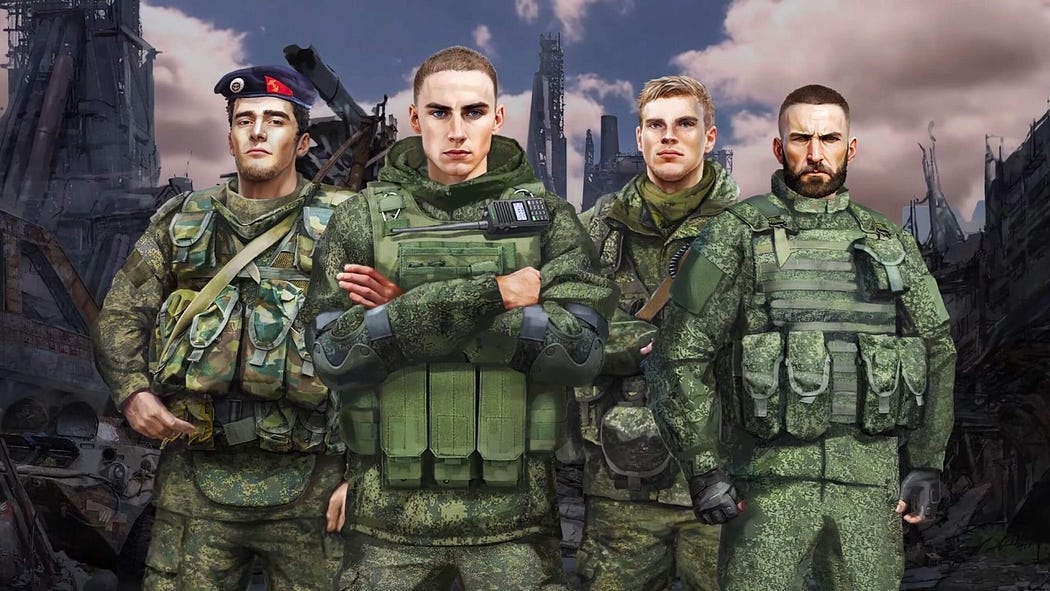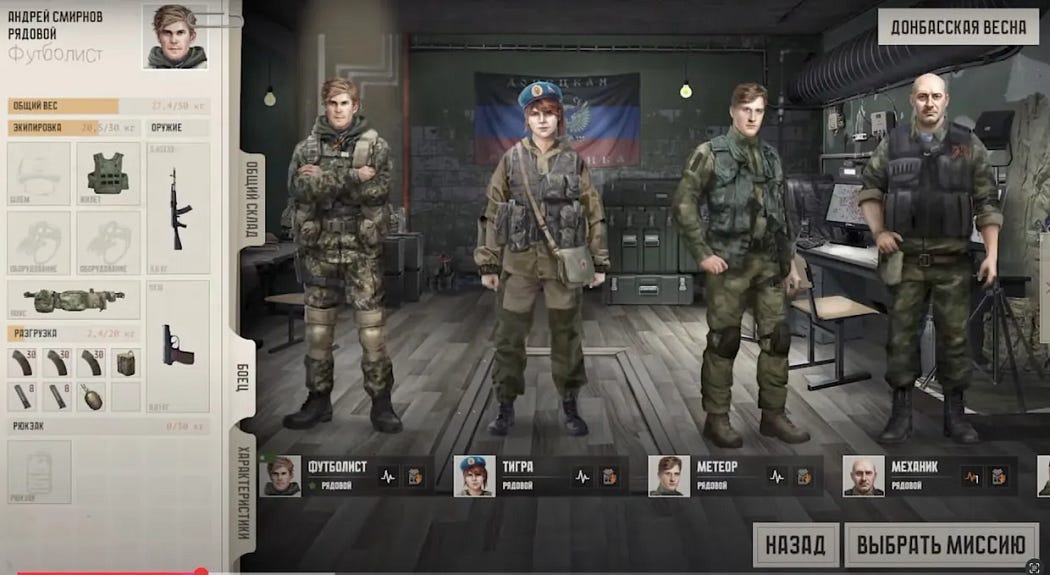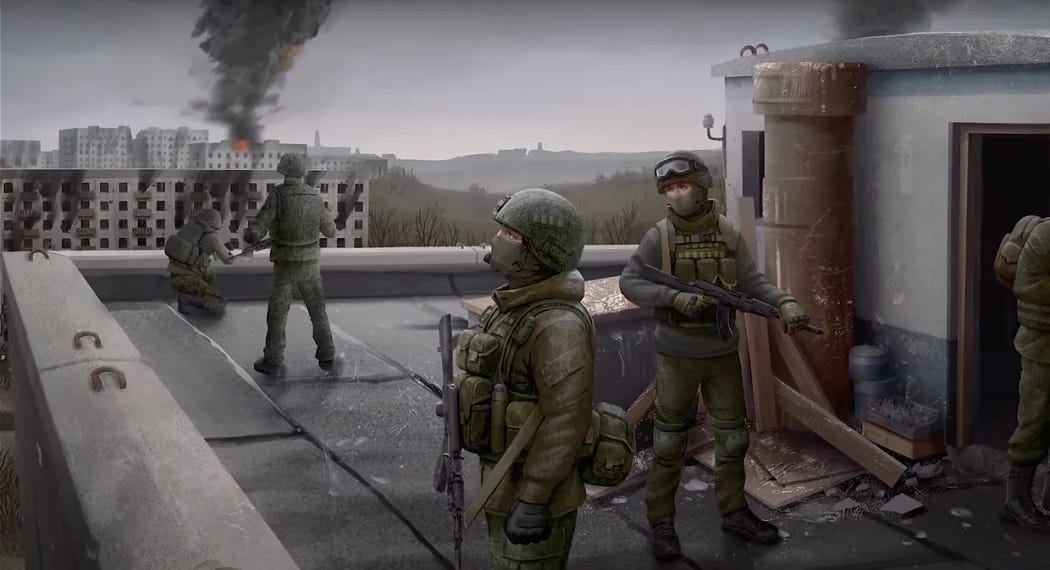Russia Turns Its War Crimes into a Video Game, and Yes, It’s as Cringe as It Sounds
I got my hands on a copy of this trash. I did not pay for it.
In 2025, the $113 billion games industry is collapsing. Mass layoffs at Microsoft, legal arguments over digital rights and consumer protections, and burnt-out development teams. So why not throw in this hot piece of garbage “game” right from the demented mind of Dmitry Anatolyevich Medvedev.
Not satisfied with bombing hospitals, deporting children, or redefining “special military operation” as a 3-year-long televised war crime, the Kremlin has now decided to release… a video game.
A video game.
[pause for laughter]
Introducing Squad 22: ZOV, Russia’s attempt to turn its invasion of Ukraine into a playable experience for the whole family, assuming your family enjoys rewriting history with a Ministry of Defense-approved narrative and graphics straight out of a 2004 Blockbuster Video budget bin.
And before we go full snark, and believe me, we will, I’ll admit, this isn’t entirely new. The US did something similar with America’s Army during the height of the War on Terror. That game, too, was government-backed and designed to recruit young people and subtly (or not-so-subtly) justify US military actions abroad.
Propaganda wears camo in every language. But Zov isn’t merely an American rah-rah wet dream; it’s a state-sponsored hallucination. The difference is that in America’s Army the game, we weren’t invading our democratic neighbor while denying it existed. (That’s next week, Canada...) ((kidding)) (((or, maybe not, who knows these days)))
The Plot (Or: How to Gaslight in HD)
Squad 22: ZOV lets players re-enact key Russian offensives against Ukraine, including the 2014 occupation of Donbas, the siege of Mariupol in 2022, and the fall of Avdiivka in 2024.
It’s kind of like Call of Duty, if you swapped out the moral ambiguity and replaced it with Kremlin fan-fiction and digital cosplay of war crimes.
In Squad 22: ZOV, you don’t play the invader, you play the misunderstood liberator. You’re not encircling cities and leveling neighborhoods; you’re “bringing peace.” Never mind the international consensus, the war crimes tribunals, or the hundreds of mass graves uncovered in Bucha and Mariupol. This game skips the inconvenient parts like a propaganda speedrun. From the opening cutscene, the narrative hits you over the head with the same stale Kremlin cocktail: ethnic Russians under threat, Ukrainian “nazis,” and Russia’s benevolent mission to restore order.
If gaslighting were a game mechanic, this game would be Elden Ring.
You select your squad of freedom-loving Donetsk irregulars, each one spouting scripted lines that sound like they were copy-pasted from a Ministry of Information Google doc. Objectives range from capturing Ukrainian “terrorist” strongholds to escorting humanitarian aid convoys that mysteriously look like armored columns. Not once do you defend your homeland from an aggressor, because according to ZOV, there was no aggression to begin with.
In this bizarro version of history, the Maidan never happened, and Ukraine is one giant breakaway province full of confused Slavs begging for Russian guidance.
There’s even a dialogue system, albeit one where every choice leads to the same conclusion: Russia good, Ukraine bad, NATO probably lurking in the bushes. This is a calculated narrative overwrite, scrubbed clean of moral ambiguity and soaked in jingoism.
The most galling part? The game treats actual Ukrainian resistance as an annoying sub-objective; just another “obstacle” to your righteous advance. Not making Ukrainian defenders the main objective is laughable, especially since Russia has suffered approximately 1,040 casualties (killed or wounded) on July 10 alone!
Squad 22: ZOV rewrites identity. It turns defenders into villains, turns occupation into salvation, and turns a very real human tragedy into a glorified training sim for cadets and cosplay militias.
Sponsored by the Ministry of Defense… Literally
When most game studios say they’re “backed by a powerful team,” they usually mean a Red Bull-fueled dev squad crunching through sleepless nights. In Squad 22: ZOV, it means the actual Russian Ministry of Defense; yes, the one currently prosecuting a war of aggression, is footing the bill and calling the narrative shots. This is a line item in the budget, signed off between weapons shipments and conscription orders.
The MoD’s fingerprints are all over it, from the game’s missions mirroring real battles (but with all the war crimes airbrushed out) to the consultation with “Special Military Operation” veterans, some of whom were likely under international sanctions while consulting on character animations.
Want to know where the mission briefing voiceover came from? Probably the same guy who drafted last month’s mobilization speech.
And let’s talk about why this even exists. This isn’t a grassroots effort by a bunch of nostalgic Slav modders. This is statecraft in Unreal Engine. Russia didn’t bankroll this project for fun.
It’s a soft power play… Weaponized nostalgia and digital propaganda are designed for impressionable teens and armchair warriors. It’s intended to normalize the conflict, give it a heroic gloss, and bury the messy parts beneath polygonal rubble and patriotic background music.
And just in case you think this is some fringe vanity project: The MoD isn’t shy about it. They’ve openly pitched ZOV as “a tool for training and awareness,” recommending it for military cadets and the Yunarmiya youth movement. If the US Army’s “America’s Army” franchise was a recruiter with a free T-shirt, ZOV is the trench sergeant barking orders in your living room, if the trench sergeant also denies your country exists.
So yes, it’s literally sponsored by the Ministry of Defense. And that’s not an Easter egg, it’s the whole damn shell.
“Gameplay” Featuring War Crimes and Broken Physics
According to reviews, the gameplay is somewhere between Door Kickers 2 and Diet War Thunder, but if you stripped both of any mechanical polish, replay value, or narrative consistency. Players manage squads of Russian troops from a top-down tactical view, because nothing screams realism like watching the battle of Mariupol play out like a chess match, minus the ethics.
Consultants on the game include Russian soldiers who participated in the siege of Mariupol, you know… for “plausible representation.” Points for realism by getting tips from the guys who helped level a civilian city.
Now, it’s easy to laugh. And we should. The game’s pixelated genocide fantasy and early-2000s aesthetics practically beg for mockery. But this isn’t harmless.
Even if Squad 22: ZOV flops harder than a T-72 on fire, the signal it sends is potent: Russia is normalizing war crimes through interactivity. They’re training the next generation not just to accept state violence, but to simulate it, happily, with headshots.
And don’t forget: the game’s being pitched to Yunarmiya, Russia’s state-backed youth paramilitary program. You know, the same one that teaches kids how to field-strip AKs and recite Stalin quotes between dodgeball matches. So yeah, this is less “gamer culture” and more “digital conscription.”
Ukraine Responds
While Kyiv has issued the usual condemnations through its Center for Strategic Communications, no Ukrainian version of Call of Duty: Resistance has emerged, at least not yet.
What has materialized is a patchwork of private-sector satire, indie dev projects, and a few unofficial mods that let you strap explosives to a DJI drone and fly it into pixelated Russian tanks. Nice… [chef’s kiss].
The message: Ukraine may not have a billion-dollar defense gaming budget, but it still knows how to troll Moscow like a champ: online, in public, and with dark humor sharper than a HIMARS strike.
But here’s the catch: Kyiv’s Ministry of Digital Transformation has bigger fires to put out, literally and figuratively. They’re busy keeping actual infrastructure online during Russian missile barrages, not crafting triple-A counter-propaganda titles.
Calls for Ukraine to lean into video game “soft power” are growing louder from esports analysts and influencers, who argue that Ukraine needs its own digital battlefield; one that reflects reality, counters Russian narratives, and captures global attention.
There have been whispers of support for homegrown Ukrainian games, titles like Sheriff of Donbas or Ghosts of Hostomel, but without centralized backing or international investment, most of these projects stall before takeoff.
For now, Ukraine’s most effective response to Russian disinformation and propaganda remains what it’s always been: documenting the real war in high-definition bodycam footage, drone feeds, and first-person testimonies shared across Telegram and YouTube.
It’s gritty, unscripted, and unmistakably authentic, everything ZOV is not. But whether that’s enough to compete in the global attention economy remains to be seen. Because in 2025, truth needs good UI too.
In the grand tradition of dictatorships trying to win hearts and minds through 16-bit graphics and dated game engines, Squad 22: ZOV feels less like the next Call of Duty and more like a modded Command & Conquer project accidentally greenlit by a military bureaucracy with no sense of irony.
This is just a bad game, full stop. It’s a digital diorama of state delusion, assembled by men who think “Nvidia RTX” is a train station in Rostov.
What’s most telling is that ZOV doesn’t just whitewash war crimes, it renders them in 2003 textures and presents them as heroic quests. And while the developers insist they’re “not ashamed,” the rest of the gaming world isn’t impressed; they’ve seen better physics in Goat Simulator.
But here’s the real kicker: This isn’t for you. It’s not for critics, or even gamers. It’s a signaling tool, an artifact of authoritarian PR culture where aesthetics are irrelevant as long as the messaging hits its target audience: young Russians, potential conscripts, and the Telegram-fed true believers who still think Bucha was staged.
And maybe that’s the most dangerous part. Not the pixels. Not the broken AI. But the fact that the Kremlin no longer needs believability, just repetition. Just enough noise to confuse the undecided, embolden the loyal, and distract from the real blood-soaked terrain of Ukraine with something that can run on grandma’s Windows 7 desktop.
In that sense, ZOV doesn’t fail because it’s a bad game. It is, but that’s beside the point. It fails because it proves the truth doesn’t need better graphics. Just better storytellers.
If this is the prequel game to the full-scale invasion, I can’t wait to see what they come up with next.
Final Score: Zero out of Ten
No points for effort. No points for building a playable war crime.
Слава Україні!






Old school propaganda meets modern technology.
Given Magyars «point system» for drones, how difficult would it be to make a game where you lead a drone squad? Of course you might have to change things due to ops security, but it can’t be difficult? Now one can say that glorification of war shouldn’t be made into a game. But it happens and Ukraine is paying the price.